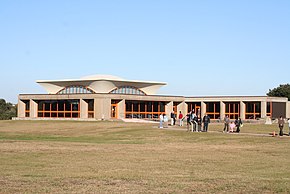Wright Brothers National Memorial
| Wright Brothers National Memorial | |
|---|---|
|
IUCN category V (protected landscape/seascape)
|
|

Monument at Wright Brothers National Memorial.
|
|
| Location | Kill Devil Hills, North Carolina, USA |
| Coordinates | 36°00′52″N 75°40′04″W / 36.014311°N 75.667897°WCoordinates: 36°00′52″N 75°40′04″W / 36.014311°N 75.667897°W |
| Area | 428 acres (173 ha) |
| Authorized | March 2, 1927 |
| Visitors | 445,455 (in 2011) |
| Governing body | National Park Service |
| Website | Wright Brothers National Memorial |
 |
|
| Official name | Wright Brothers National Memorial Visitor Center |
| Designated | January 3, 2001 |
| Designated | October 15, 1966 |
| Reference no. | 66000071 |
| Architects | Rogers & Poor; National Park Service |
| Architecture | Art Deco |
Wright Brothers National Memorial, located in Kill Devil Hills, North Carolina, commemorates the first successful, sustained, powered flights in a heavier-than-air machine. From 1900 to 1903, Wilbur and Orville Wright came here from Dayton, Ohio, based on information from the U.S. Weather Bureau about the area's steady winds. They also valued the privacy provided by this location, which in the early twentieth century was remote from major population centers.
Authorized as Kill Devil Hill Monument on March 2, 1927, it was transferred from the War Department to the National Park Service on August 10, 1933. Congress renamed it and designated it a national memorial on December 4, 1953. As with all historic areas administered by the National Park Service, the national memorial was listed on the National Register of Historic Places on October 15, 1966. The memorial's visitor center, designed by Ehrman Mitchell and Romaldo Giurgola, was designated a National Historic Landmark on January 3, 2001. The memorial is co-managed with two other Outer Banks parks, Fort Raleigh National Historic Site and Cape Hatteras National Seashore.
The Wrights made four flights from level ground near the base of the hill on December 17, 1903, following three years of gliding experiments from atop this and other nearby sand dunes. It is possible to walk along the actual routes of the four flights, with small monuments marking their starts and finishes. Two wooden sheds, based on historic photographs, recreate the world's first airplane hangar and the brothers' living quarters.
The Visitor Center is home to a museum featuring models and actual tools and machines used by the Wright brothers during their flight experiments including a reproduction of the wind tunnel used to test wing shapes and a portion of the engine used in the first flight. In one wing of the Visitor Center is a life-size replica of the Wright brothers' 1903 Flyer, the first powered heavier-than-air aircraft in history to achieve controlled flight (the original being displayed at the National Air and Space Museum in Washington D.C.). A full-scale model of the Brothers' 1902 glider is also present, having been constructed under the direction of Orville Wright himself. Adorning the walls of the glider room are portraits and photographs of other flight pioneers throughout history.
...
Wikipedia

